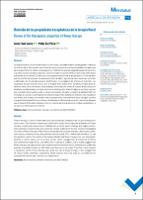| dc.contributor.author | Lauro, Javier | |
| dc.contributor.author | Saz Peiro, Pablo | |
| dc.date.accessioned | 2023-06-15T16:41:30Z | |
| dc.date.available | 2023-06-15T16:41:30Z | |
| dc.date.issued | 2023-03-31 | |
| dc.identifier.citation | Revista Peruana de Medicina Integrativa. 2023; 8(1). | es_PE |
| dc.identifier.issn | 2415-2692 | |
| dc.identifier.uri | https://hdl.handle.net/20.500.12959/3927 | |
| dc.description.abstract | La terapia floral, basada en el uso de esencias de flores conocidas como Flores de Bach, ha sido objeto de estudio e interés en el campo de la medicina complementaria y alternativa durante las últimas décadas. Estas esencias fueron creadas por el médico británico Edward Bach en la década de 1930, quien postuló que ciertas flores silvestres poseían propiedades curativas específicas que podían ayudar a equilibrar las emociones y mejorar el bienestar general de las personas. Desde entonces, la terapia floral ha sido utilizada en diversas partes del mundo para abordar una amplia gama de condiciones físicas y emocionales, desde el manejo del estrés y la ansiedad hasta el alivio de síntomas asociados con enfermedades crónica. | es_PE |
| dc.description.abstract | Flower therapy is a form of alternative and complementary medicine that has gained interest in
recent years. This literature review was conducted to assess the therapeutic properties of flower
therapy. A search was conducted on PubMed with a specific search strategy, and original studies,
observational or experimental, and systematic reviews published in the last 10 years investigating
the utility of flower therapy or Bach flowers for people’s health were selected. Letters to the editor,
case reports, narrative reviews, and editorials were excluded. Of 41 initial studies identified, 11 met
the selection criteria. The results of this review indicate that flower therapy may have therapeutic
benefits in various areas such as anxiety control, stress management, improvement of family
and professional relationships, and self-control in eating. In addition, some studies suggest that
flower therapy may help reduce labor duration and improve fetal vitality. However, the quality and
quantity of available studies are still limited, and the results are mixed. Therefore, more research
is needed to confirm these findings and clarify the role of flower therapy in the management
of various health conditions. Importantly, flower therapy should be used as a complement to
conventional medical care, and not as a replacement. | es_PE |
| dc.format | application/pdf | es_PE |
| dc.language.iso | spa | es_PE |
| dc.publisher | Seguro Social de Salud (EsSalud) | es_PE |
| dc.relation.uri | https://rpmi.pe/index.php/rpmi/article/view/710 | es_PE |
| dc.rights | info:eu-repo/semantics/openAccess | es_PE |
| dc.rights.uri | https://creativecommons.org/licenses/by-nc-sa/4.0/ | es_PE |
| dc.subject | Esencias florales | es_PE |
| dc.subject | Revisión | es_PE |
| dc.subject | Salud | es_PE |
| dc.subject | Floral essences | es_PE |
| dc.subject | Review | es_PE |
| dc.subject | Health | es_PE |
| dc.title | Revisión de las propiedades terapéuticas de la terapia floral | es_PE |
| dc.title.alternative | Review of the therapeutic properties of flower therapy | es_PE |
| dc.type | info:eu-repo/semantics/article | es_PE |
| dc.subject.ocde | https://purl.org/pe-repo/ocde/ford#3.02.29 | es_PE |
| dc.identifier.doi | https://doi.org/10.26722/rpmi.2023.v8.n1.710 | |






